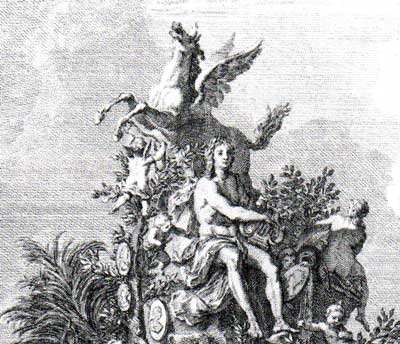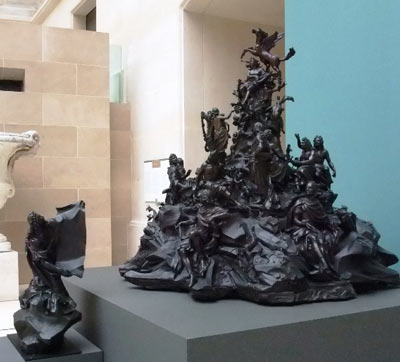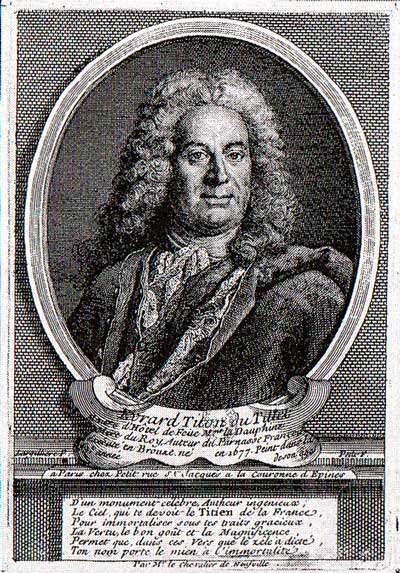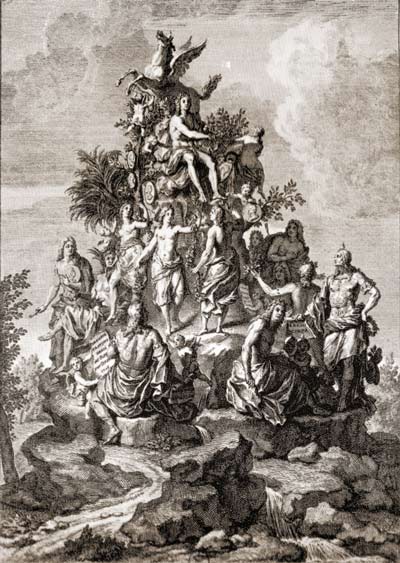 The French Parnassus - etching by Tardieu
The French Parnassus - etching by Tardieu
Du Tillet wanted to celebrate the great poets and musicians of the time of Louis XIV. What he had in mind was a huge monument, with larger-than-life statues, that he would place in the middle of a garden or in a square.
The monument would represent mount Parnassus with laurels and palm trees, and feature Louis XIV/Apollo on the top and, below him, the Graces, madame de la Suze, madame des Houllières and mademoiselle Scudéry, holding garlands of flowers.
On a lower level, the Muses : Corneille, Molière, Racan, Segrais, La Fontaine, Chapelle, Racine, Boileau, and Lully holding a portrait of Quinault. Other artists would appear on medallions hanging on the trees or held by winged Genies : Marin Marais, Campra, Michel de La Lande, Elizabeth-Claude Jacquet de La Guerre, André Destouches, J.B. de Lully (Lully's son), and Colin de Blamont...
Some other 160 names of writers and musiciens would appear on six phylacteries. One would be entirely dedicated to the musicians : the Gaultier, Chambonnière, Cambert, Henri Dumont, Michel Lambert, Pierre Gautier, Marc-Antoine Charpentier, Pascal Colasse, Guillaume Minoret, J.-B. de Bousset, Théobalde, Jean-François Lalouette, Sébastien Brossard, J.-B. Senaille, Salomon, J.-L. Marchand, François Couperin, J.-B. Moreau, Nicolas Bernier, Michel de Monteclair, Jean-Joseph Mouret, Jean-François Dandrieu, Henri des Marets, Michel de La Barre, Charles Gervais, Jean Matho, Jean-Fery Rebel, Forqueray, Bertin, Lacoste, Nicolas Clérambault, Th.-Louis Bourgeois, Grenet, Jacques Aubert, Joseph-Nicolas Royer, Antoine Calvière, Joseph de Boismortier, J.-B. Stuck....
A phylactery would name past and present sponsors and music lovers, like Charlemagne, François 1er, Louis XIII, Philippe d'Orléans, Emperor Charles VI, Charles-Armand-René de la Trémouille, marquis de Brassac, comte d'Eu, Madame Adélaïde (as a violin player), Madame Victoire (as a harpsichord player).... One would be dedicated to women famous in the art of singing : Hilaire, Saint Christophe, Rochois, Le Froid, Chappe, De Lalande... and another one to the famous female harpsichord players : Certain, Perron, Guyot, La Plante, du Hallai & Dandrieu...
Du Tillet, helped by Nicolas de Largillière as artistic advisor for the portraits, contracted the sculptor Louis Garnier to built up the monument. In 1718, an intermediate-sized model was cast in bronze, but building the full-size monument was very costly and Du Tillet had to find sponsors. To promote his project and raise founds, he commissioned an etching (see the illustration above).
In 1727, as he hasn't yet managed to get enough money and thought maybe he would unable to bring his project to a successful conclusion, he published a Description du Parnasse françois, exécuté en bronze, followed by a Liste alphabétique des Poètes et Musiciens rassemblés sur ce monument.
In 1732 there was a second edition titled Le Parnasse françois, enlarged with notes on the life of various musicians and poets. Additional notes were published in 1743 and 1755.
Titon du Tillet died in 1762 without having seen his dream come true. The bronze model was given to Louis XV by Du Tillet's heir and nephew. During the 19th century it was kept at the Bibliothèque Nationale but, as it was taking too much place, they decided to send it to Versailles where it was dismantled and neglected for a long time. Many of the small pieces (medallions and phylacteries) disappeared. The work is now part of the collection of the Musée de l'Histoire of the Château de Versailles where it can be seen.
---
From June 30 to September 27, 2009, 'The French Parnassus' will be in Los Angeles, still part of the exhibition Cast in Bronze : French Scultptures from Renaissance to Revolution, at the J. Paul Getty Museum.
Labels: Du Tillet, French Parnassus, Iconography, Sculpture
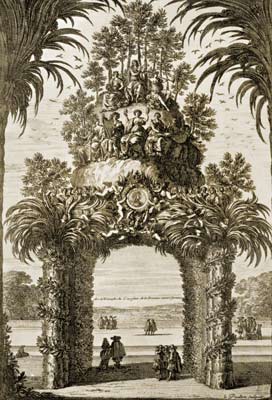
 17th & 18th-Century history, arts & music
17th & 18th-Century history, arts & music
